Today, there are many ways you can make money online, and YouTube is just one of them. That said, there's a wide gap between how much the highest earners and the average YouTuber make. So, how much does YouTube pay on average, and can you actually make money from your own YouTube videos?
You can find a lot of advice online on how to start a YouTube channel. But, monetizing a YouTube channel is a bit more complicated than it looks on the internet. Let's take a closer look at how creators make money on YouTube and how much YouTube pays.
Overview of YouTube's payment system
There is a lot of curiosity about YouTube monetization and how the whole payment system works. YouTube makes money through advertisers. Anyone who creates videos on YouTube can make money from ads they run on their YouTube videos. Your YouTube earnings are calculated based on two metrics:
- CPM (Cost Per Mille): How much money advertisers pay YouTube for every 1,000 ad impressions shown on the creator's videos.
- PRM (Revenue Per Mille): How much a creator earns for every 1,000 ad impressions on their videos.
One thing to know, though – to run the ads on your videos, you have to be part of the YouTube Partner Program.
YouTube Partner Program
To get a share of YouTube ad revenue and start making money on YouTube, you'll need to join the YouTube Partner Program (YPP).
As a member of the YouTube Partner Program, you can place ads on your videos and monetize your content. To be eligible, your channel must meet these requirements:
- Live in a region where the YouTube Partner Program is available
- Adhere to YouTube's community guidelines
- Accumulate more than 4,000 valid public watch hours in the past 12 months
- Have a minimum of 1,000 subscribers on your channel
- Possess a linked Google AdSense account
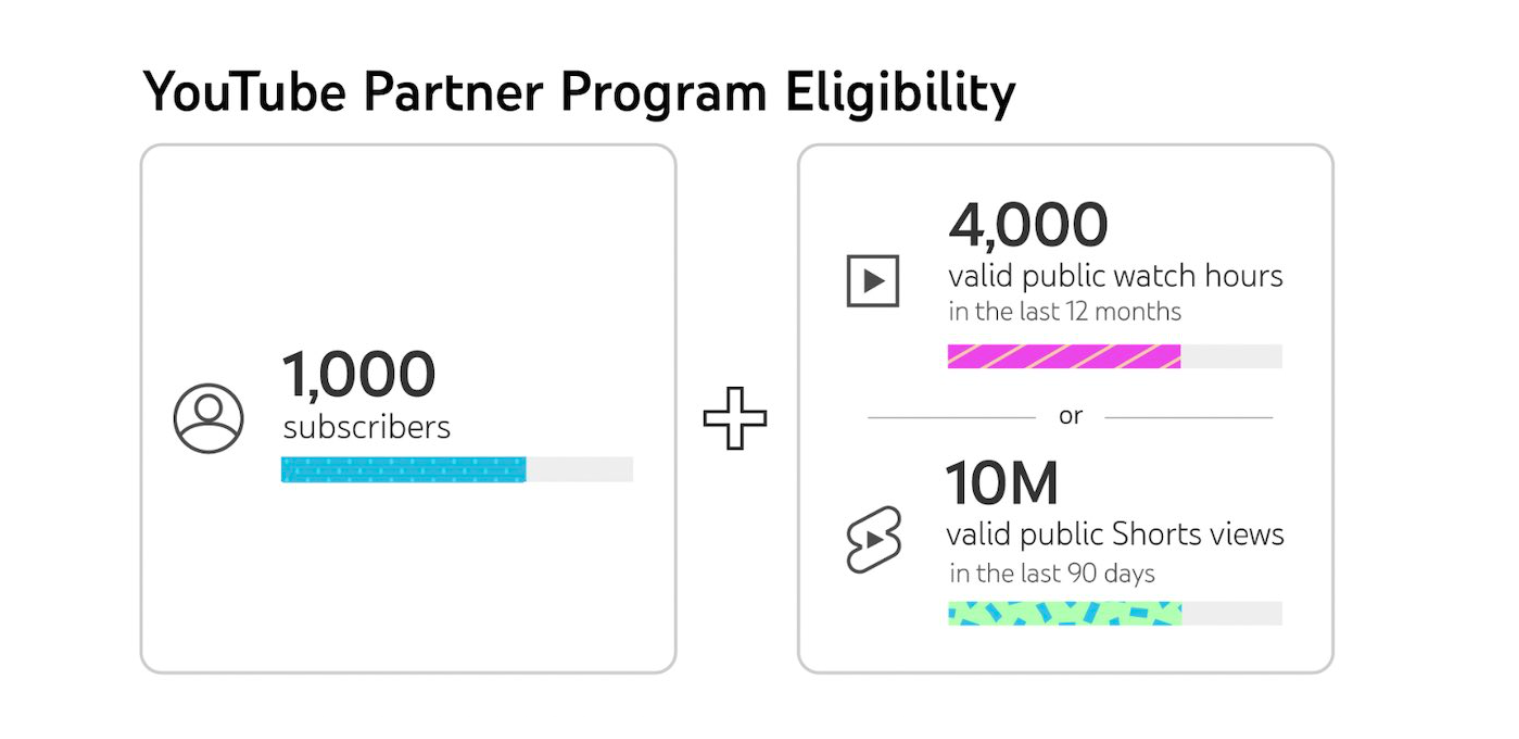
If your channel fulfills these criteria, you're eligible to apply for the YouTube Partner Program. Once YouTube approves your application, you can start monetizing your videos.
How much does YouTube pay per view?
The primary way creators make money on YouTube is through ad revenue. This simply means YouTube shares a cut of revenue with eligible creators when viewers watch ads that appear on their videos.
However, earnings aren't based purely on the number of video views but rather on ad views. Each YouTuber has an individual CPM (cost per 1,000 views), which tells us how much a creator makes for every 1,000 views.
CPMs vary by creator and niche. So, how much does YouTube pay per view? Well, looking at Google's AdSense calculator, rates range from $4 to $24 per 1,000 video views. Here's how it potentially translates into earnings:
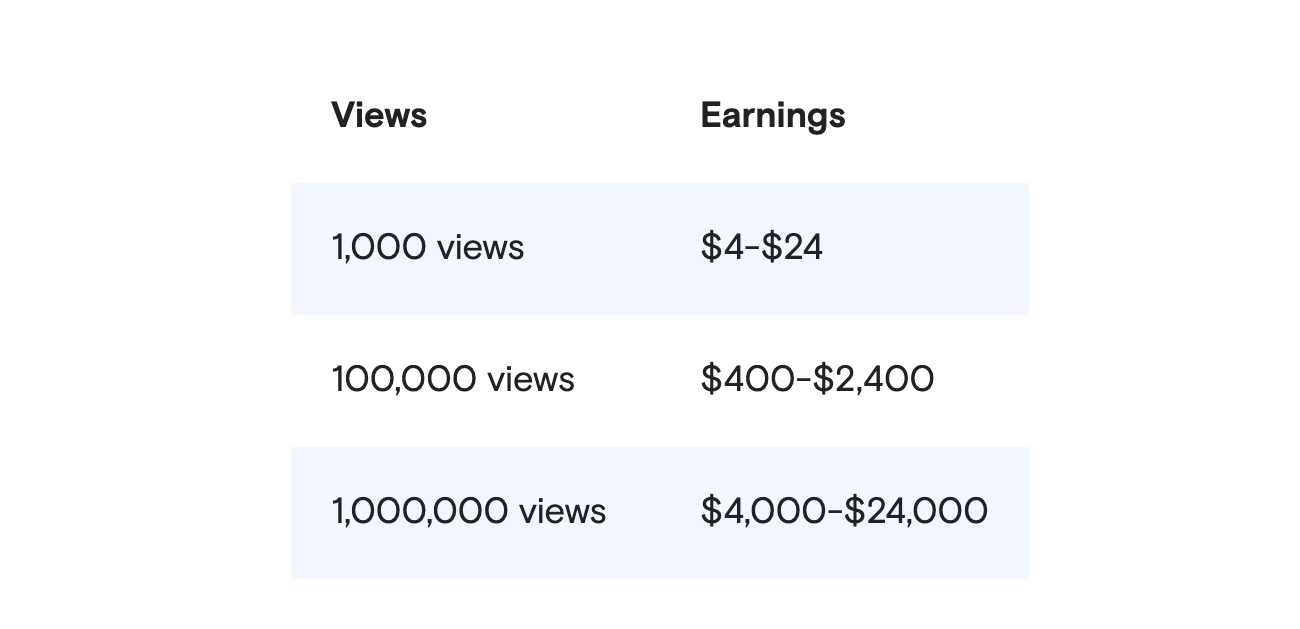
Reaching a million views is when YouTubers start to see significant earnings. YouTubers who have over a million subscribers make around $60,000 per year. Growing your YouTube subscribers is no easy feat, though — only 42,000 channels have more than one million subscribers.
Your niche also impacts your earnings per view. Some of the niches with the highest CPMs include:
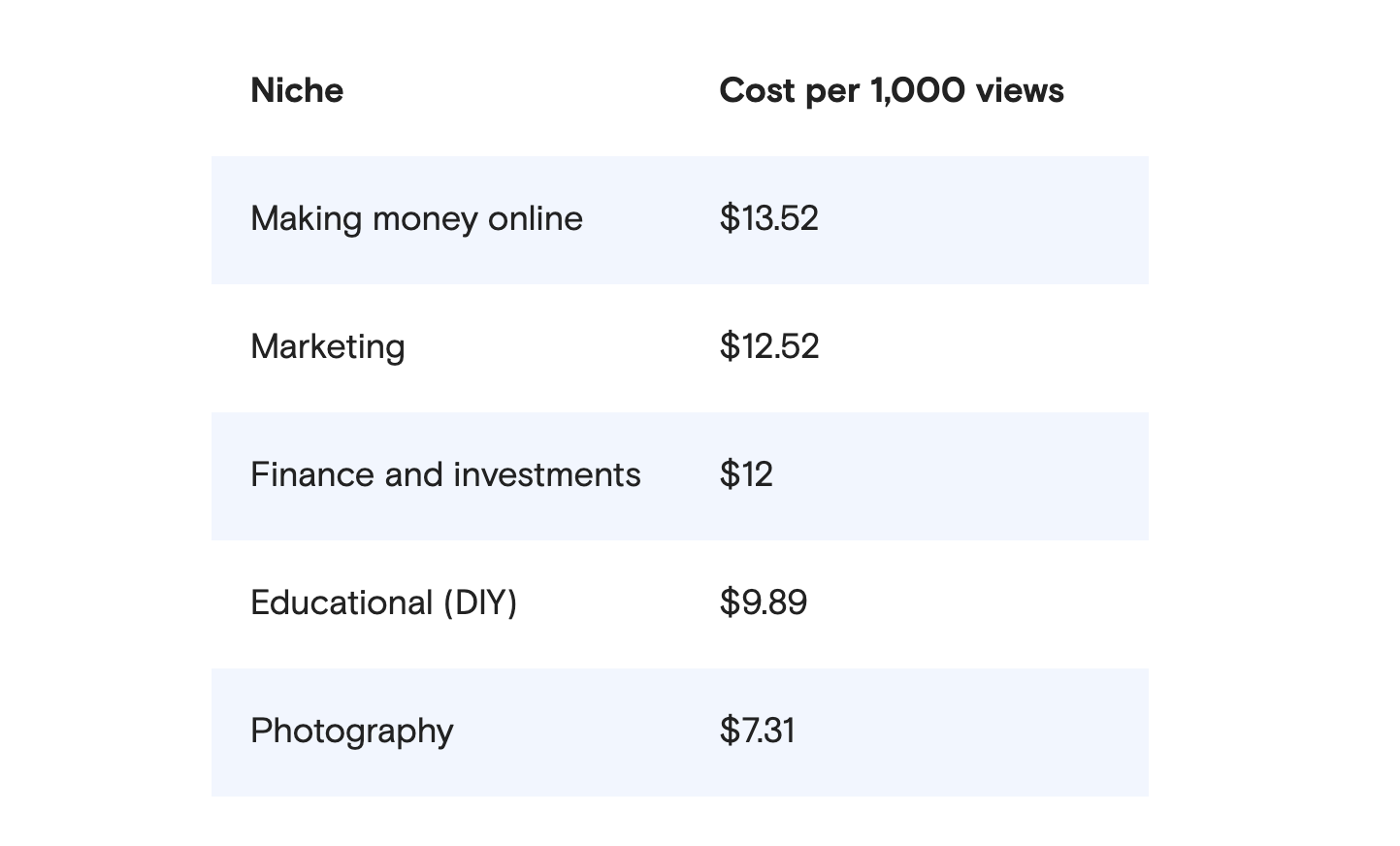
Again, these numbers aren't set in stone. The more engaged your audience is, the more ads they watch on your videos, and the higher your CPM. Therefore, you'd be wise to focus on building an engaged audience and creating other income streams to make more money.
How much does YouTube pay for 100k views?
If you're curious to know how much does 100K views on YouTube pay, you're definitely not alone. Unfortunately, there is no one YouTube earnings calculator that can tell us exactly how much getting 100K views on YouTube will pay. However, we can estimate based on the data available online.
It's important to note that YouTube income per view varies greatly depending on the niche and other factors. Some creators might make more than others even if they receive the same 100K views on their YouTube videos. If your goal is to make as much money on YouTube as possible, then you want to focus on creating videos in one of the most profitable niches on YouTube.
So, how much money can you expect to make if you get 100K views on your videos? Well, a lifestyle content creator from NYC, Alexis Eldredge, shares that for 190K+ views in one month, she made around $1,800, while a few months later, for 180K+ views, she made around $2,200.
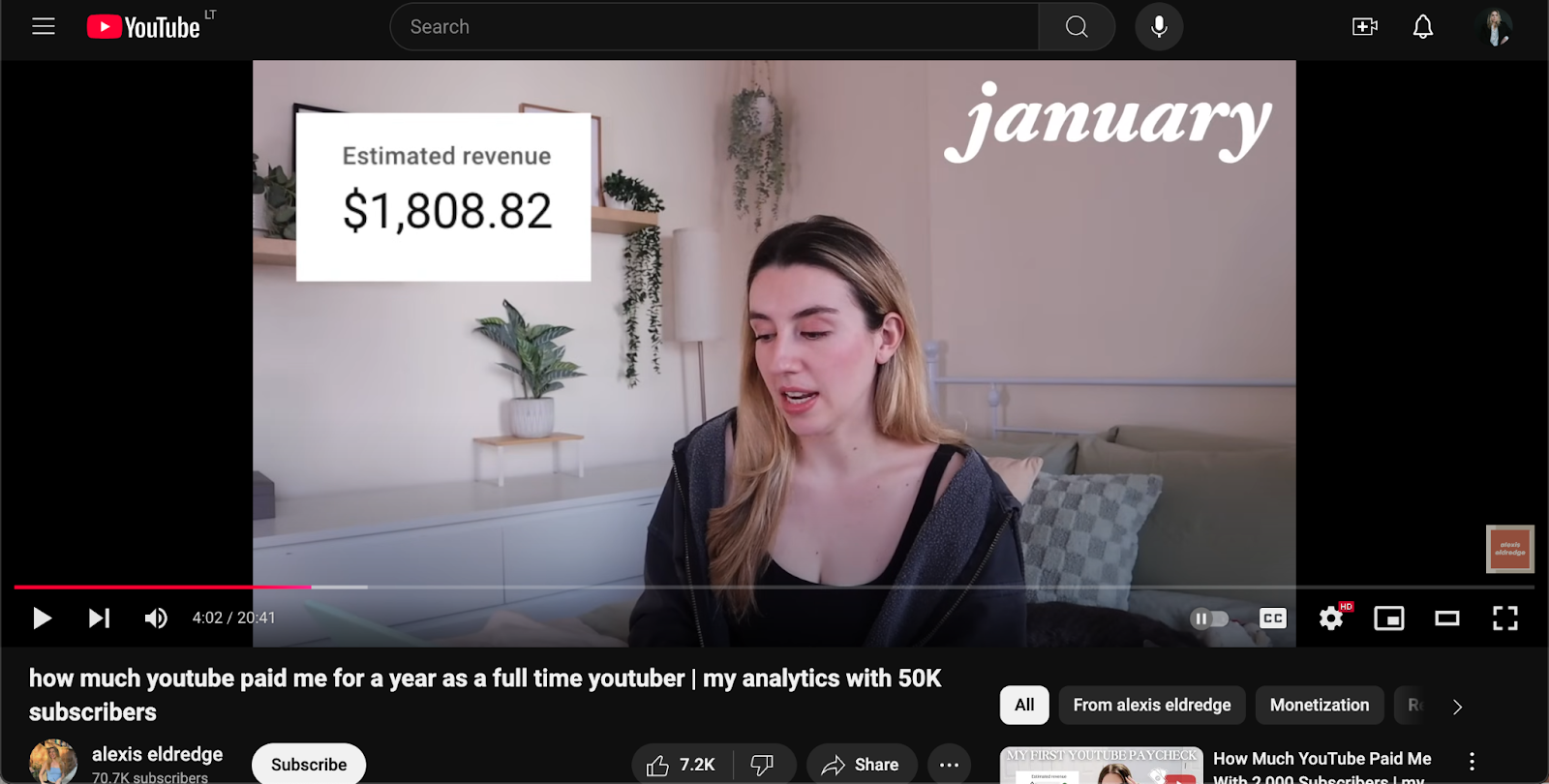
How much does YouTube pay for 1 million views?
Okay, but how about bigger numbers? How much does YouTube pay for 1 million views? 1M views might look like a lot of views that should make tons of money for the creator. However, you might be surprised to find out the reality.
Lifestyle content creator from Sweden, Athina, shared that her video, which got over 1 million views, made just over $4,200.

Another YouTube creator, Budget Treasures, who is in a personal finance niche, shared that for 1 million views her whole channel got, she made over $10,000.

As you can see, ad revenue can vary greatly from channel to channel, and you don't need one video to go viral and collect millions of views to make money.
Additional income streams for YouTube creators
The good news is that making money through YouTube ads isn't the only way to monetize your YouTube channel. Other ways YouTubers make money include:
- Affiliate marketing: Promote products or services and earn a commission on sales made through your referral links.
- Products and courses: Sell your own digital products or online courses to viewers.
- Merchandise: Creators create and sell branded merchandise directly to their audience.
- YouTube membership: Viewers support creators through a monthly fee and get access to exclusive content and perks.
- Sponsorships: Brands pay creators to feature their products or services in videos.
We'll dive into each a bit deeper below.
Affiliate Marketing
Affiliate marketing is a straightforward way to boost your YouTube income. The way it works is simple – you promote products you enjoy and earn a commission from sales made through your unique affiliate links.
Here's how to do it:
- Identify the products you love and want to endorse. This could be anything from the equipment to the products you use to create videos.
- Sign up for affiliate programs. You can search for the brand name and affiliate program to find them.
- Include these links in your YouTube video descriptions. Direct your viewers to the description of your videos, where they can find the link and make a purchase.
For example, YouTuber Jules Acree includes a few sentences in video descriptions for paid partnerships. It includes her affiliate link and a promo code.

It's also common to include a list of products that you feature in videos with affiliate links to purchase them. Further down in Jules's video description is a list of clothing she wears in the video and links to buy.
Products and courses
According to The State of the Creator Economy, one of the top three ways creators supplement their income is by selling their own products and services. There's a good reason for that.
With ad revenue, you only get a small percentage (55%), and Google gets the rest. Whereas, when you sell your own digital downloads, online courses, and other products, you get most of your revenue. A small (5%-10%) usually goes toward tools, platforms, and supplies to create and sell your products, but most of that hard-earned revenue is yours.
Another benefit to selling these types of products is that digital products take minimal upfront investment since you're primarily investing your time and expertise. Unlike physical merchandise, they can be sold indefinitely without any inventory or shipping hassles.
Many YouTubers use Teachable to create and sell their products or coaching services. Examples of digital products you can sell with Teachable include:
- Online courses
- E-books or digital guides
- Printable worksheets
- Social media design templates
- Digital planners or calendars
- Journals
- Fonts
- Spreadsheets
Learn how to create and sell an online course using your pre-existing YouTube videos in three days.
Sarra Cannon is an indie author and has a YouTube channel with around 10,000 subscribers. Alongside her book sales, she also offers writing and publishing courses through Teachable:
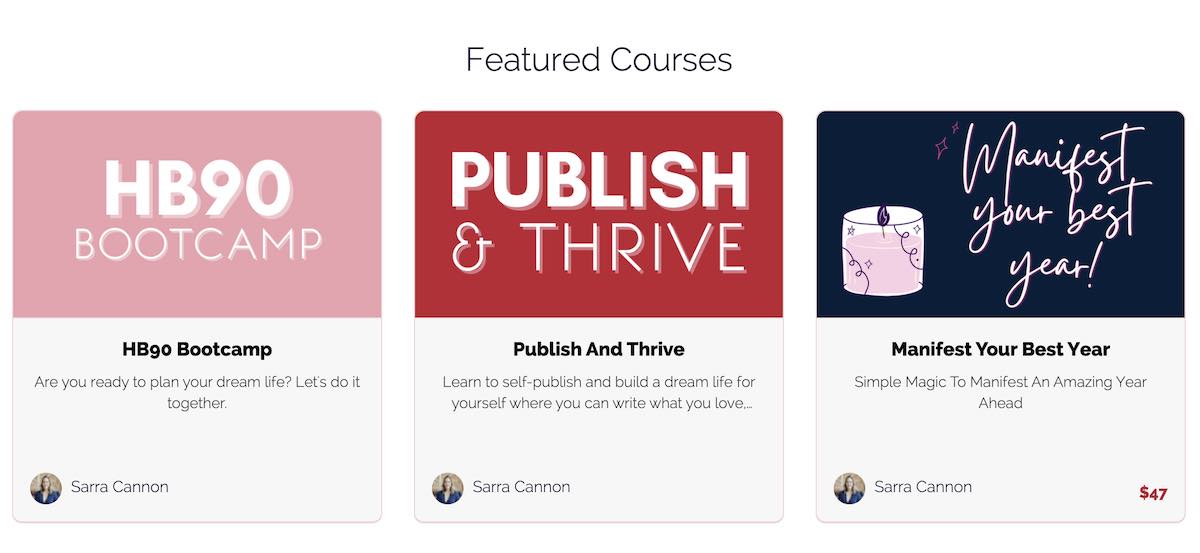
Merchandise
That said, tangible products are still marketable. YouTubers with large audiences (usually over one million) sell merch and physical products. The biggest YouTubers like PewDiePie (111 million subscribers) and Emma Chamberlain (12 million subscribers) sell merch and launch other businesses.
PewDiePie launched his own line of energy drinks with GFuel.
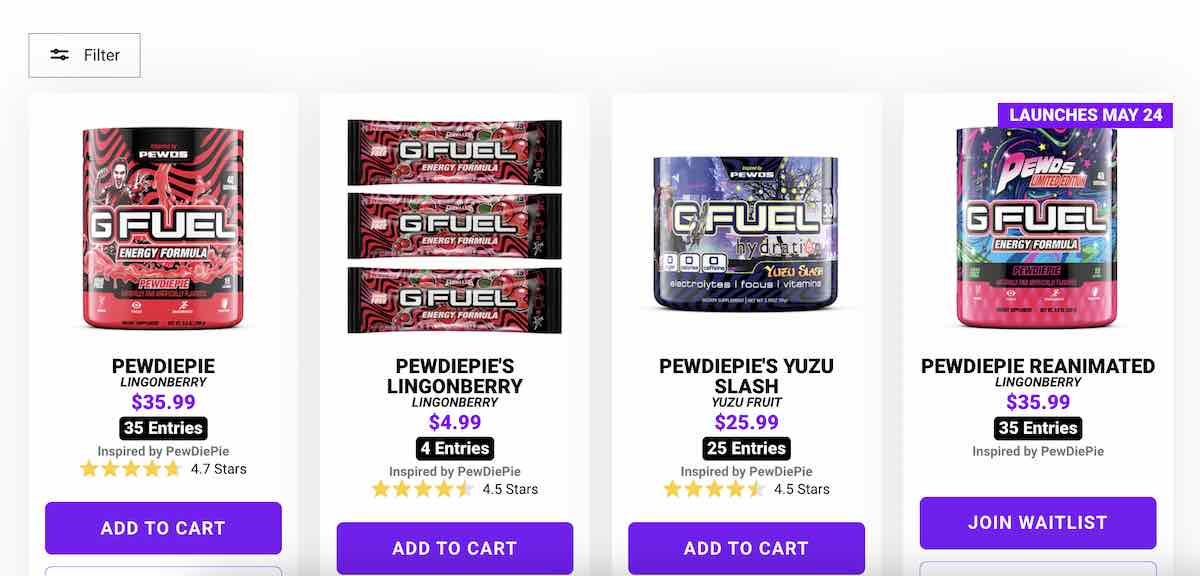
While Emma Chamberlain founded Chamberlain Coffee, selling tea, coffee, and matcha directly to her audience.
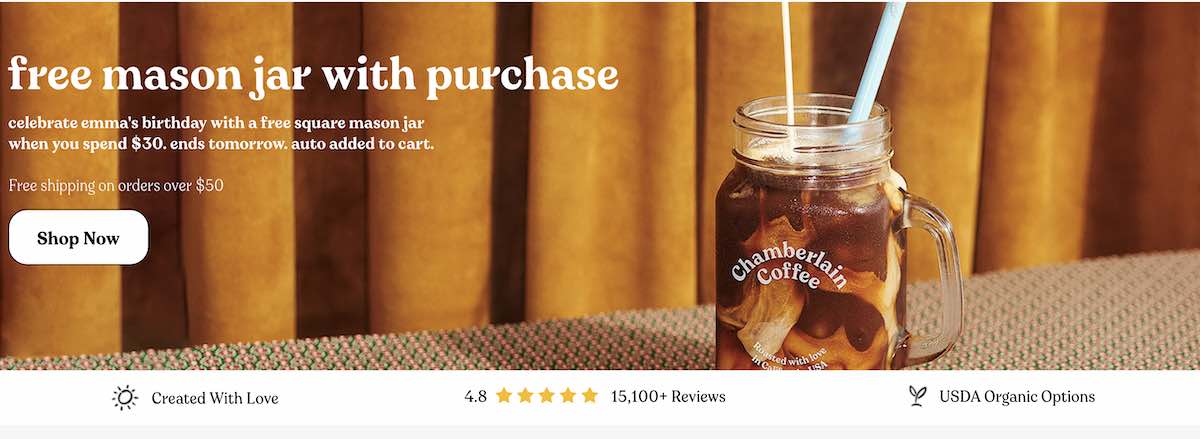
You don't need to be a huge YouTuber to start selling merchandise, but you may want to wait until you get at least 100,000 subscribers to make the investment. You'll have startup costs to create your own merch, store inventory, and ship products that you don't have for digital products.
However, if you want to jump into merch sales, you can also start small with low-cost physical products like stickers and t-shirts. Then, expand into other higher-cost products when it's time.
YouTube Memberships & Shorts
YouTube has a channel membership feature that allows creators to offer paid subscriptions to their viewers.
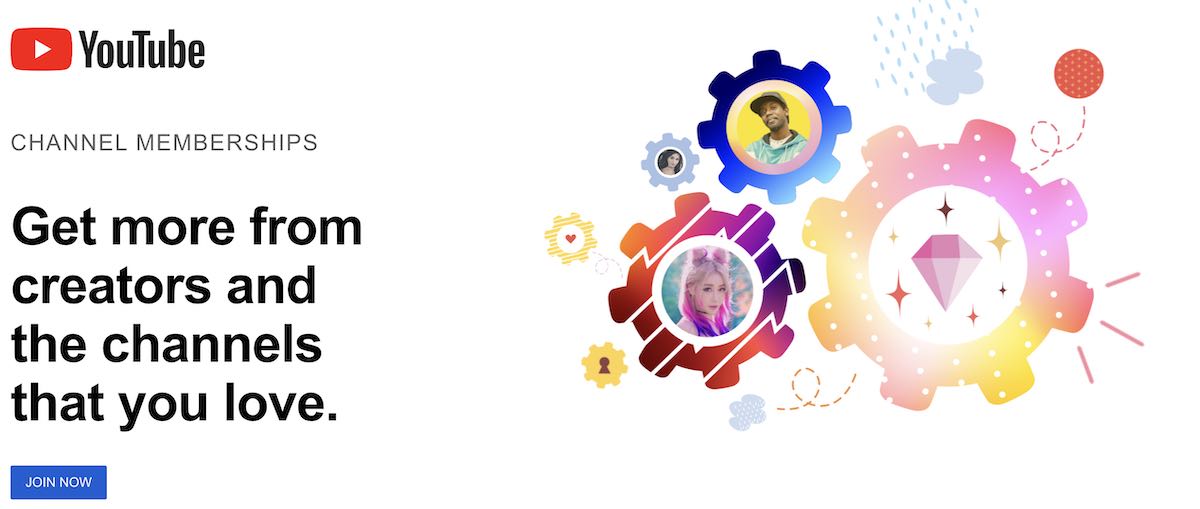
It's a beneficial way for creators to earn income for three reasons:
- Direct support: It provides fans an opportunity to directly support their favorite creators by paying a monthly fee.
- Exclusive content: In exchange for their support, members gain access to exclusive content not available to regular viewers. This could include behind-the-scenes footage, early access to videos, members-only live chats, and more.
- Consistent income: Unlike ad revenue, which can fluctuate based on views and CPM, memberships offer a more stable and predictable income stream.
YouTube channel memberships are most effective for creators with a loyal audience that's willing to pay for extra content and engagement opportunities.
Also, YouTube now has a whole new way to monetize short-form content through Shorts. If your channel is part of the YouTube Partner Program, you can also monetize your Shorts videos, which gives you an extra income source. The great news is that it's very easy to learn to create Shorts, and it takes less time than long-form content.
Sponsorships
One of the most profitable ways to make money on YouTube is through sponsorship deals. YouTube sponsorships, where brands pay creators to promote their products within videos and other forms of content, usually bring in more money than ad revenue.
According to the 2023 report from influencer marketing platform IZEA, here's the average cost for a brand to sponsor a YouTube post by subscriber size.
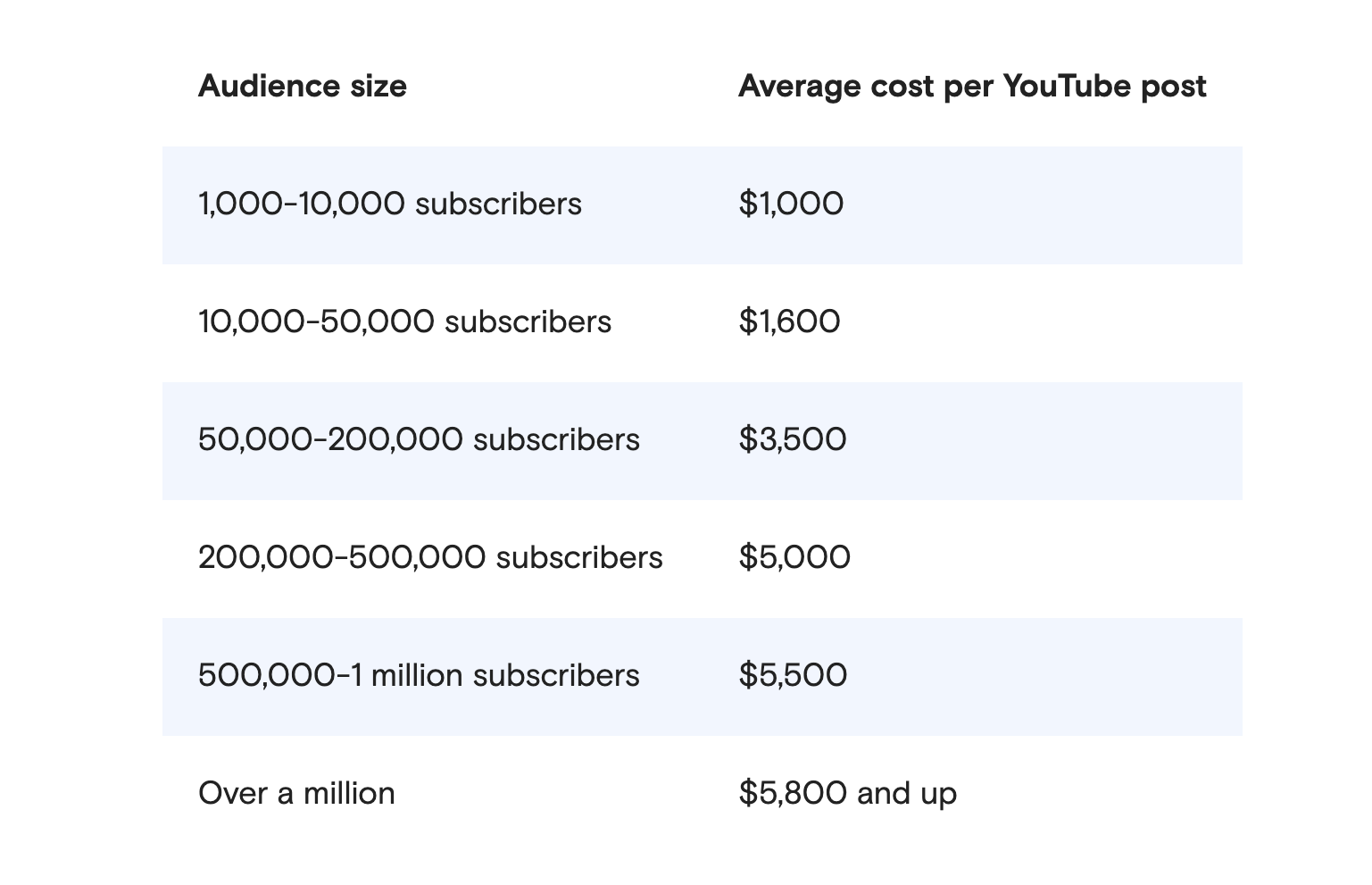
To get sponsorships, follow these tips:
- Grow your channel and audience: A larger, engaged audience generally means more value to sponsors.
- Create a media kit: You'll send a media kit, a deck of your channel stats, sponsorship packages, and value to help brands decide to partner with you.
- Join influencer or creator marketing platforms: Platforms like TapInfluence and IZEA connect brands to creators looking for paid sponsorships.
When you land a sponsorship, make sure to adhere to FTC guidelines and disclose sponsorships in your videos. Not only is this legally required, but it also builds trust with your audience.
Factors that affect YouTube earnings
While YouTube gives an opportunity for anyone to make money on their platform, the income from the ads can be unpredictable. All that is due to several factors:
- Content niche: Certain niches like finance, technology, health, and business have a higher CPM than other niches due to strong advertiser demand, which might affect how much you can make from ads on your videos.
- Viewer demographics: Certain age and interest groups are more attractive to advertisers than others, and these can influence your CPM.
- Geographic location: Ad rates in countries like the United States, United Kingdom, and Canada are higher, so your earnings will depend on where you live.
- Engagement rate: Your video length and watch time or retention rates can heavily influence how much money you make from ads.
- Seasonality: During certain seasons, like the holiday season in December, ad rates might be higher than during summer.
Some of these factors are out of your control (seasonality), while others can be changed (engagement rate). Because YouTube is a platform where anyone can post, it's also important to remember that changes in algorithms and other policies might also influence your YouTube income – we have seen it happen before when advertisers cut their spending on ads shown on YouTube due to certain creators' controversial behavior.
Tips for increasing YouTube revenue
If you're determined to increase your YouTube revenue, we have some actionable tips to help you do just that. Here are some easy things you can do to make more money on YouTube:
- Create longer videos: Longer videos (over 8 minutes long) are eligible for mid-roll ads, which can increase your income.
- Focus on high-CPM niches: Certain topics like finance, business, technology, health, and real estate have higher CPM (on average), so focus on creating videos around those topics to achieve higher CPM.
- Optimize your videos: Optimize your thumbnails and titles to encourage people to click on your videos, and optimize your description with keywords and hashtags so your videos can be found through YouTube's search.
- Improve engagement: Find ways to make your videos more engaging so people are more inclined to comment, like, and watch your videos to the very end.
- Post consistently: YouTube rewards consistency, so create a posting schedule that works for you and be consistent with it to improve your chances of being recommended by YouTube's algorithm.
- Optimize posting times: If you're creating Shorts to promote your main channel (which you should consider doing), make sure you're posting at the best times to get as much engagement as possible.
Final thoughts on YouTube payments
So, how much does YouTube pay creators? As you can see, it truly varies. The biggest YouTubers earn millions, but that's a small percentage of the platform's users. However, with over 10,000 subscribers, you can still make anywhere from $1,000 to $5,000 per video through brand sponsorships alone. Keep in mind that it takes work to create content, build an audience, and pitch to brands.
Creators have many resources online to make money – whether that's on YouTube, Teachable, Instagram, or another platform. Ultimately, the most successful creators, on YouTube and elsewhere, have multiple revenue streams and focus on the ones that bring in the most income.
If you're serious about diversifying your YouTube income and building multiple sources that will help you drastically increase your revenue, check out our money resources on Teachable on how to create sustainable income sources beyond YouTube.
How much does YouTube Pay FAQs
Let's answer some of the most popular questions people have about monetization on YouTube.
How many views do you need to get paid on YouTube?
To earn from YouTube, creators must join the Partner Program and accumulate 4,000 public watch hours. The number of views doesn't directly determine earnings, but maximizing ad views is key. However, this can be difficult as about 40% of viewers use AdBlock, bypassing video ads.
How much does a YouTuber with one million subscribers make?
A YouTuber with one million subscribers can earn varied amounts depending on views, niche, and other income sources. On average, they could make $1,500 to $2,500 per video from ads with 500,000 views.
Do YouTubers get paid monthly?
Google pays eligible YouTubers in the YouTube Partner Program monthly through AdSense, typically between the 21st and 26th. You must exceed the $100 minimum payment threshold. If earnings don't reach this threshold, they roll over to the next month.
How does YouTube calculate payments?
Every monetized channel has a CPM (Cost Per Mille) rate, which shows how much money YouTube makes from the ads shown on the videos per 1,000 views. YouTube keeps around half of it, and the rest is paid to the creator on a monthly basis if their payments meet the required payment threshold.
What Is YouTube CPM, and how does it affect earnings?
YouTube CPM means Cost Per Mille, and it's a metric that determines how much money advertisers pay to YouTube per 1,000 views of the videos that run the ads. The higher the CPM, the more money the YouTube channel makes. A CPM can fluctuate depending on the industry, geographical location, and even audience demographics.
Do YouTube Shorts earn revenue?
Yes, YouTube Shorts can earn revenue if your YouTube channel is part of the YouTube Partner Program. Your Shorts videos will earn ad revenue from ads shown in the Shorts Feed in between videos, which is separate from the ads shown on long-form video content.
How can creators increase their earnings beyond ad revenue?
There are many different ways creators can increase their revenue. You can sell online courses and digital products, utilize affiliate marketing, do sponsorships, create a YouTube channel subscription, start Patreon, or sell merch.
Join more than 150,000 creators who use Teachable to make a real impact and earn a real income.


